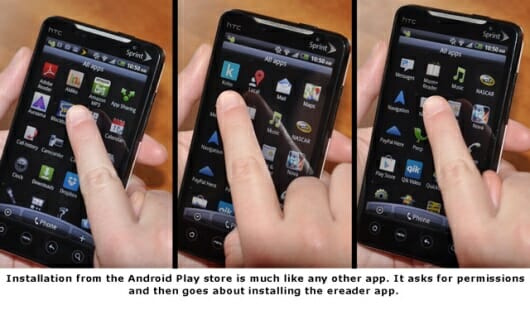
By Jeff Bach (@jjbachauthor)
Most of us don’t think about converting our books to ebooks until after they’re completed and ready for publication. In this article, Jeff Bach explains how we can view them before they’re ready to be published and why we might want to think about doing that.
I stumbled across this article, Smartphones: The Next Home of the Ebook? here on The Book Designer site discussing the potential of smart phones as ereaders. This led me to wonder about uploading and viewing my current work in progress on a smart phone (an old HTC Evo) and my iPad, as well as viewing it in a Firefox epub reader on my laptop browser.
I was interested in checking my work and making sure cover images, internal images, table of contents and fonts were reasonably behaving across a range of mobile devices.
It turned out that I was able to upload and read my work in progress on both smart phone and iPad. Overall, I found this process quite reasonable.
Evaluating an epub file on mobile devices
When it comes to mobile devices, there are probably about 14,999 combinations of hardware, software, app version and OS versions.
Please consider:
- What I saw in my testing and described below may not be exactly what you see on your devices, but it should be conceptually in the same ball park.
- This is a pre-release exercise to evaluate how an epub file looks on mobile ereaders. I’m not expecting perfection, I just want to get an early first look at my epub file on mobile ereader apps, so I can fix any issues early on rather than finding something at the last minute.
For me, an unexpected benefit of testing my epub file like this turned out to be that simply reading my words on a different screen in a different layout revealed typos and errors that I had repeatedly glossed over on my main laptop.
Dropbox is a central part of this exercise. This is a free online service letting users upload a file once and then access that file from multiple other locations and devices. Dropbox is similar to ftp in the web development world, but more user friendly. In this test exercise, the main benefit of Dropbox is the ease of accessing the epub file in my online Dropbox folder from a smart phone and an iPad. On both phone and iPad, the Dropbox client proved easy to use and similar in appearance.
I use Apache Open Office Writer as my main writing platform. When it’s time to produce an epub file I turn to the wonderful writer2epub extension that Luca Calcinai has written and released as an open source extension for Open Office. Once I have exported an epub file from my Open Office original file, I open that file in Sigil (version 0.7.3) and rework the epub file as needed.
I think there’s a big mind shift that happens here as you go from a narrowly scoped writing effort (e.g. in Open Office) to a more widely scoped authoring effort (e.g. in Sigil for epub) with a more equal emphasis on writing and layout.
The big writing packages handle the layout as you write. Epub, on the other hand, is all about html, which lacks any built in rules for layout. You have to add that layer yourself (aka CSS). I think Sigil does a fine job with their supplied CSS. I find constructing the table of contents to be a particularly great part of Sigil. Another issue I now appreciate is cover images. They can be tricky, particularly with iBooks/iPads.
The epub file I used was made with Sigil and included:
- a cover image
- h1/h2 headings and the resulting table of contents
- several chapters
- several images within a couple of the chapters
I thought that gave me enough to evaluate the look and feel of my epub on my phone and iPad and several ereader apps.
I was curious how the page turn happened, I wanted to see:
- how pages were default justified
- the default font, font size and choices
- the quality and size of images
- if image captions stayed with the images
- if text flowed around right and left floated images
Beyond that list of topics I just read through my ebook on each of the ereader apps and on both phone and iPad and tried to be aware of unexpected issues if/when I encountered them.
Setting it up
- Signup with Dropbox and then go to the app stores and download the free Dropbox client on your smart phone and on your tablet. In my case, this was on my HP laptop, an HTC Evo, and an iPad. I found creating an account and installing Dropbox to be pretty standard.
- Download the ereader apps from the Android Play store. From the Play store I installed the free versions of four ereaders onto my HTC Evo:
- Aldiko (version 3.0.2)
- Moon+ (version 2.2.6)
- Kobo (could not find a version number)
- the Cool reader.

- Go to Apple’s app store on your iPad and install the iBook app.
- On your main laptop install the EPUBReader extension (version 1.4.2.4) within your Firefox web browser.
Each of the ereader apps allows you to view your epub file as a local file on your smart phone, iPad and browser. This viewing is a private local affair with no uploading to third party public stores, no validation requirements, etc. You are not publishing anything. You are privately and locally viewing your work on the above reading devices, courtesy of your private Dropbox folder.
If you have an iPhone in lieu of an Android, conceptually your work flow is the same, but you will need to go through the specifics of the iPhone app download/install.
With the necessary apps installed:
- Go back to your laptop.
- Open Firefox.
- Login to the Dropbox website.
- Upload your epub file from laptop to your account within the Dropbox cloud. I see this as the Dropbox “client” on my laptop uploading the file to the Dropbox “cloud” on the web
- With the file uploaded, you can now leave your laptop behind and go to your phone.
- On the phone, single tap on the Dropbox icon to open the Dropbox client. The file you uploaded at the beginning over on your laptop is now visible within the Dropbox cloud viewed from the phone Dropbox client.
- Another single tap on the target file within the phone Dropbox client gets you a dialog box asking which of the installed ereaders you want to use to start reading the file.
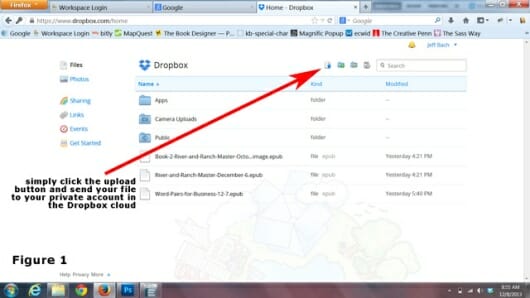
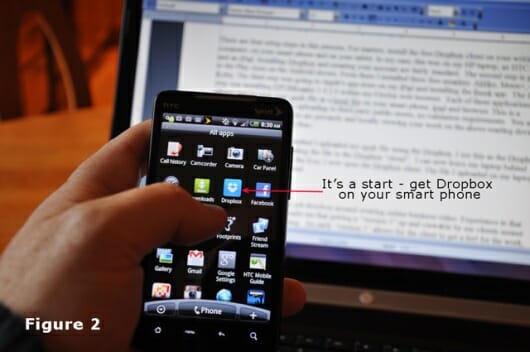
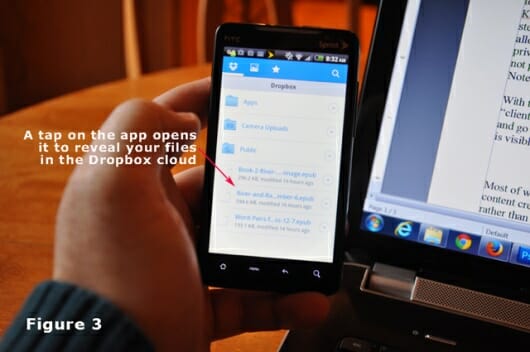
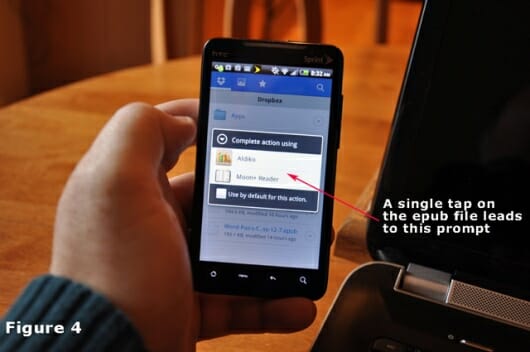
You need to go through this process for each of the ereader apps you want to use. All but one of the ereader apps behaved the same way in this step.
So far I have not been able to get Kobo to appear in that dialog box list seen in Figure 4. For the Kobo reader I hunt around within the Kobo menu and use the search option to find a copy of my epub file and import that into Kobo’s library.

A simple single tap on the ereader app you choose in the dialog box seen in Figure 4 is all you need to open and start reading your epub file in your phone ereader. The ereader apps I used all offered the same basic choices, with minor differences between the four.
Twenty minutes of messing around on your phone will have you up to speed on the basics of each ereader. Google searches offer up an array of helpful answers to navigate the feature set of each ereader app. Your mileage may vary and of course you are free to use others of the many good ereaders available.
The whole point of this exercise is to see how ereader apps handle your epub file, prior to publishing your book and having readers alert you to the surprises they find in your epub file after it is published.
Tips For Cover Images
- Within Sigil, be sure the picture is named “cover.jpg” in both the code and the browser window.
- Right click on the image in the Sigil file browser and open the “Add Semantics” option and mark the image as a cover image.
- Add a line in the meta section of the content.opf file to get the cover image to show on the iBook shelf. Easier to view the image below than to try and describe in text.
- Keep clicking the green arrow (top right of the UI) until your file perfectly validates.
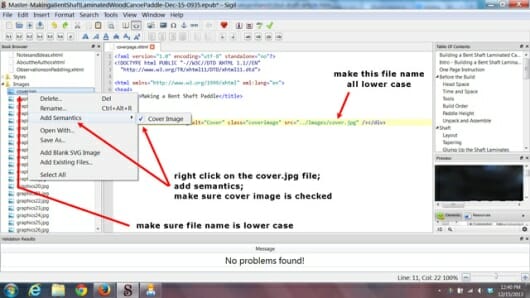
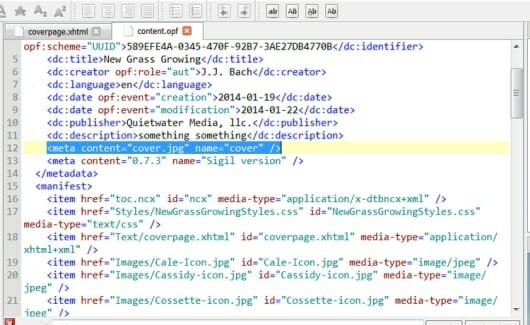
The most valuable thing I discovered was that the same epub file with the same exact cover image appeared differently in the Aldiko app relative to the Moon+, Cool, and Kobo readers. This was immensely frustrating but valuable, because at least I now know that my cover image works on three mobile readers and not on the other.
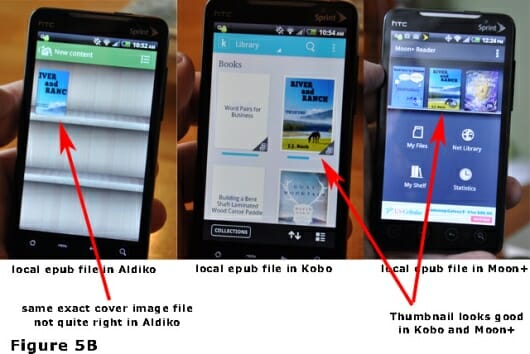
To my eye, the cover image looks good in Moon+, Cool, and Kobo readers while Aldiko shows the cover image in a “zoomed in” fashion. I suspect that image dimensions are in play here and that CSS is also involved.
I found that Aldiko appears to be based on Adobe DRM technology. At this point I can only speculate that it handles images differently relative to Moon+, Cool, and Kobo. The Moon+, Cool, and Kobo readers are not based on the Adobe technology as far as I can tell. Tech support emails eventually yielded Aldiko responses blaming me for using the wrong image and offering no suggestions. I still have not found any advice on optimum cover image dimensions or image best practices, so I have no firm answer as I write this article.
Each ereader comes with its own default CSS. Each ereader also has menu options that turn external CSS off and on. Playing with these settings and evaluating how each setting affects your epub reader is valuable experience.
Other than image frustrations, Aldiko, Kobo, Cool, and Moon+ worked very well with actually reading the text of my epub. The default fonts, font sizes, page justification, and backlighting all worked quite well for my eye. The table of contents in all the readers appeared as expected. At this stage I’m happy, although I am left wondering about the state of Aldiko’s image display. If your book has images and you want to support mobile readers, then early testing of your epub file could be well worth your time.
Uploading and checking the epub file tends to be an iterative process. Remember that old scientific method from high school? Maybe it was college. It has not changed since then and continues to suggest making one change at a time and then evaluating that change in a new version.
Each time I make a new version I like to add/update the time in the file name. As I am testing and making new versions, once I upload the epub from my laptop Dropbox client to the Dropbox cloud, it is a simple check to look at the time stamp in the file name and verify that I am looking at the most recent version of my epub file. I thought this simple step proved to be the most important in my evaluating. Once I start to make changes, it is easy to forget if I have uploaded the latest version or not. Adding the timestamp into the file name makes it easy to check the version on my laptop against the version in the Dropbox cloud.
It is also worth noting that in Windows Explorer on my laptop I like to have the Date Modified column displayed and not the Date column. Right click on the column headings in Windows Explorer and you’ll see what I mean.
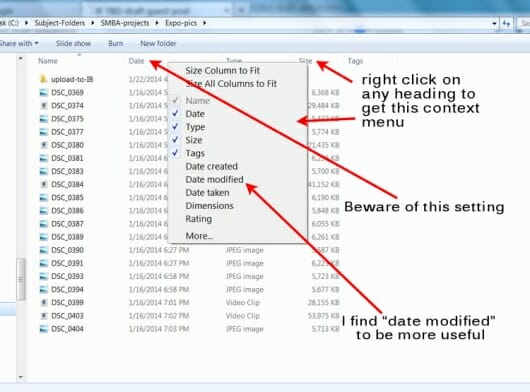
I may be suspicious, but I think deleting the current file from both device ereader and Dropbox prior to uploading the fresh file is an important part of the process. I start with removing the local epub file from each of the ereaders. You will need to remove the local file in each ereader you have used.
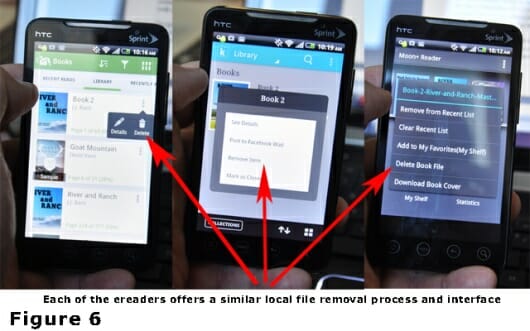
Once the local epub files are removed from within each reader app, I then go to the Dropbox client on my phone or iPad and remove the file from the Dropbox cloud.

Let’s move on to the iPad
Although in this article I describe the iPad separately, when I test I am going back and forth between phone ereader apps and the iPad iBook app concurrently. With the epub file in the Dropbox cloud, I single tap to open the Dropbox client on my iPad.
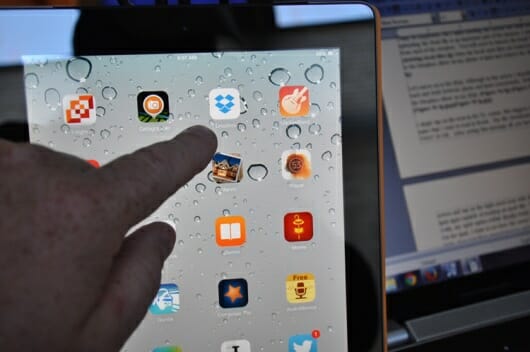
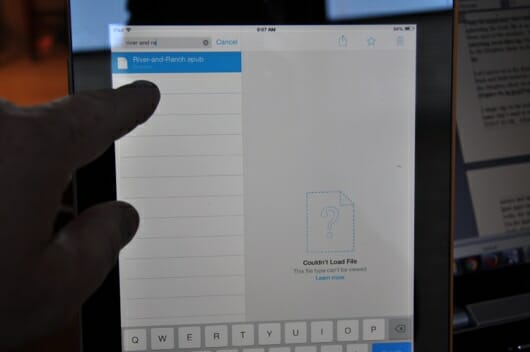
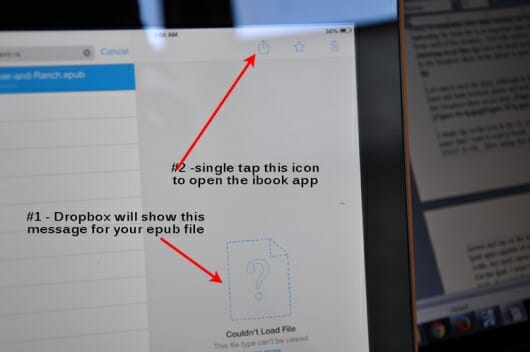
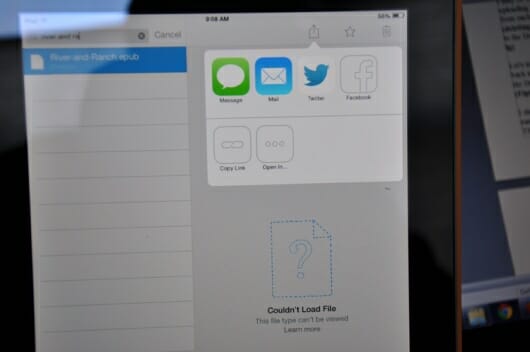
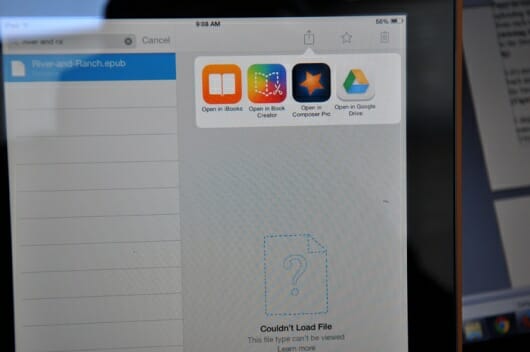
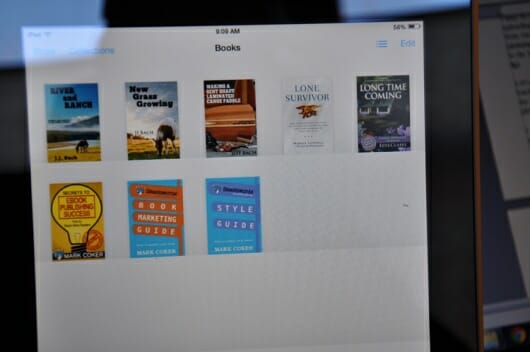
With the iPad Dropbox client open:
- Select from the displayed list of files or search for the file.
- Single tap on the file name that you want to read in iBook. The file downloads and displays a “couldn’t load file” message. THAT IS OK.
- After seeing this message all you have to do is go to the upper right corner of the iPad screen and tap on the right-most icon with the downward swooping arrow.
- That tap reveals a list of the iPad apps capable of reading an epub file. “iBooks” is one of the listed options. Tap iBooks once and voila, your epub opens within iBooks ready to go.
- On the iPad, you want to see:
- how the cover image looks on the iBook shelf
- if the table of contents look right
- if text flows around images
- what effect do the default settings have
Removing the local file from iBooks is similar to the ereaders.
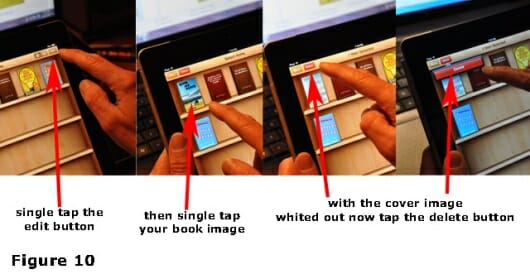
I also like to view the epub file within a web browser. I use Firefox and a Firefox extension simply called EPUBReader.
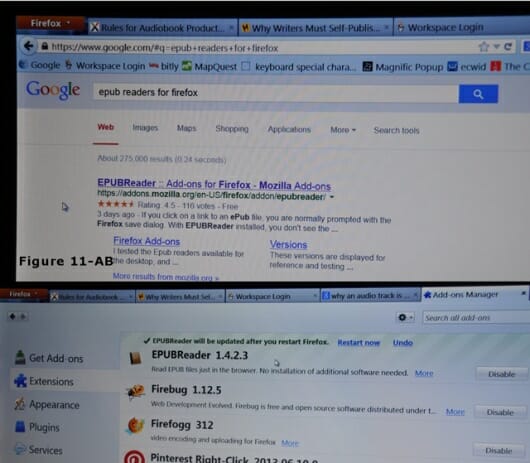
Installation is a snap. To open the epub file using EPUBREADER, I just drag and drop the epub file onto the Firefox icon on my desktop.
Adobe Digital Editions (ADE) is mentioned by many in the epub testing space. I did download and use it a bit. It is a quick install and a quick test. Like Aldiko, and likely for similar reasons, it broke on the same images in the same file that looked good on all my other testing apps and devices. Other than the image issue, it does seems to work OK as a testing preview device for text-centric issues. For me, it did nothing that other pieces of my testing workflow weren’t already doing better.
For all the attention that epub is getting, looking good in Amazon and on Amazon devices remains paramount. So I think the Kindle Previewer deserves a shout out. When I started in 2009, everything was done manually via the KDP interface in a web browser. Flash forward to January 2014 and downloading, installing and using the Kindle Previewer was a huge change for me relative to earlier methods.
The Kindle Previewer took my very same epub file I was testing with elsewhere, converted it (including large color images) and offered me a choice of three different simulated Kindle devices to view the converted file. Very easy to use. I think every indie author should download and use the Kindle Previewer. I think it is well worth using to evaluate your file and how well in converts to the mobi format. Please note that I still adhere to the image size limit of 127kb.
I did not use iTunes in this testing process, mainly because I use an Android phone and not an iPhone. Downloading my file via Dropbox was effectively an end around using iTunes. Working in iTunes is certainly another possible route to go when testing local files.
My experience with the Aldiko reader app left a bad taste in my mouth. It frustrates me that Aldiko, so far, seems to break on the very same images that Kobo, Cool, Moon+, iBook and EPUBREADER all seem to handle quite well.
I remain shocked that I have been unable to find any image best practice recommendations from either Aldiko or Adobe. At this point I cannot find a fix and am left wondering what to do, other than recommend the other reader apps. On the upside, if your book contains few images, then you may not have any issues. I thought Aldiko handled text just fine.
Before you believe me completely and give up on Aldiko, do try one setting that might change things a bit.
- Get to the bottom bar menu and tap the “Tt” icon.
- Tap the “more” option.
- Look for the “Advanced formatting” checkbox.
- Clear it or fill it and evaluate your images after each change.
It looks to me like this turns external CSS on and off. Remember – change one thing at a time and observe the results.
Conclusions
When all is said and done, I came away from this exercise with several conclusions:
- I found ereader apps on a smart phone to be pretty reasonable overall. Not quite consistent, but still quite usable.
- The issues I noticed are likely related to CSS. One reader app turns on external CSS by default while another reader app uses its own CSS by default. The setting for turning external CSS off and on was buried in different locations and called different names within each app. I thought the bottom line was OK though, with each reader I could find the setting and turn it on/off and get the page to look like I wanted.
- If your ebook is fiction containing few images, I think you should expect fairly smooth sailing regardless of which reader app is used to view your epub file.
- Amazon still remains the most important spot for my ebooks. Using the Kindle Previewer as part of this evaluating process gives me confidence that my ebook is meeting Amazon’s requirements.
- I thought the iPad/iBook combination did a great job with an epub file. I feel good about my epub file meeting Apple’s book store requirements, although I have not yet explicitly uploaded it to the Apple store (remember this is an early preliminary file checking exercise)
- My personal favorite ereader app is a tie between the Moon+ reader, and the Cool reader. I liked the parchment background of the Cool reader. Kobo did everything right once I had the file imported. It just didn’t behave like the other reader apps, but Kobo did display text and images just fine. Aldiko broke on the images I used. It broke on the same exact file that worked everywhere else with regard to cover images and images within the chapters. It did handle text well, as you would expect.
I enjoy writing. I also enjoy this dawning era of control for indie authors and self publishers. As mobile devices proliferate, people are increasingly using them to read. I think this is an opportunity for authors.
Evaluating your work as an epub file on the devices and apps your readers are likely to be using should be fairly important to every author. Evaluating your epub file early on in your writing phase can help you spot problems.
I think knowing that your ebook looks good and performs well on a smart phone and the many reader apps that people can use on those phones is well worth investing some of your time!
 JJ Bach owns Quietwater Media, a content creation firm in Stoughton, WI. In his offtime he is an author and is also seeing an uptick in producing ebooks for clients’ marketing efforts as well. His latest authoring effort is a non-fiction book on making bent shaft laminated wood paddles, which you can find on Amazon or direct on his website.
JJ Bach owns Quietwater Media, a content creation firm in Stoughton, WI. In his offtime he is an author and is also seeing an uptick in producing ebooks for clients’ marketing efforts as well. His latest authoring effort is a non-fiction book on making bent shaft laminated wood paddles, which you can find on Amazon or direct on his website.
Photo credit: Johan Larsson via photopin cc


